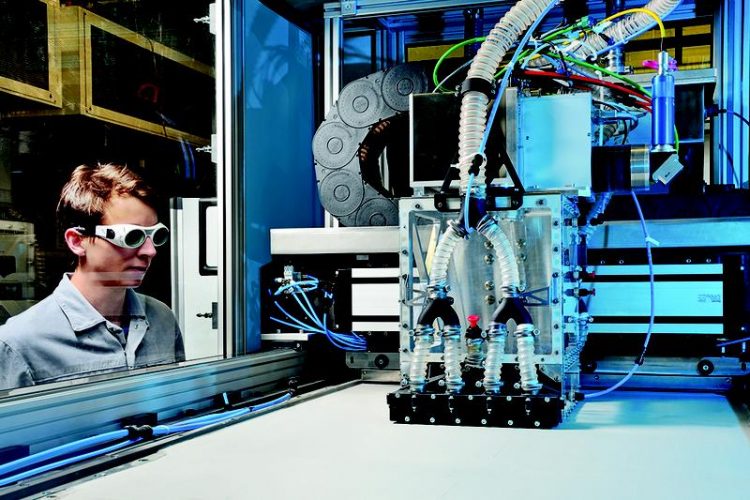Integrating One’s Sights on the Factor of 10: “futureAM – Next Generation Additive Manufacturing”

The Laser Powder Bed Fusion system offers a very large, effectively usable installation space (1,000 mm x 800 mm x 500 mm). © Fraunhofer ILT, Aachen, Germany
The complete process chain serves as the common theme
Under the leadership of the Fraunhofer Institute for Laser Technology ILT in Aachen, “futureAM – Next Generation Additive Manufacturing” was launched in November 2017 to accelerate the additive manufacturing of metal components by at least a factor of 10.
“We are focusing on the complete process chain from order processing through design and simulation all the way to production in the machines”, explains Christian Tenbrock, research associate at Fraunhofer ILT and project coordinator of futureAM.
“This approach is very important to us, as integration is at the very heart of the project”. For a year now, the research platform has been developing digital process chains, scalable and robust AM processes, system technology and automation as well as tailor-made AM materials.
On the subject of scalable processes, Fraunhofer ILT is presenting a machine configuration for the Laser Powder Bed Fusion (LPBF), also known as Selective Laser Melting (SLM), of large metal components in Frankfurt am Main.
The Aachen-based scientists have developed a new laser head for the laboratory system – already shown at the last formnext – with a very large, effectively usable installation space (1,000 mm x 800 mm x 500 mm), which increases productivity by a factor of 10 compared to conventional LPBF systems. The researchers are currently implementing the configuration, and in 2019 the first practical trials will start with this prototype system.
High-speed laser metal deposition in three dimensions
A multi-award-winning technology is involved in “Extreme High-Speed Laser Metal Deposition (EHLA)”, which can coat, repair or additively manufacture components in a particularly economical and environmentally friendly way.
This technology has already proven its worth by applying thin protective layers, for example on meter-long offshore cylinders at high speeds. So far, EHLA has been used only in rotationally symmetric parts. The next step is to create 3D geometries. For this purpose, a prototype plant is being built in Aachen, where the workpiece is moved in a highly dynamic manner with up to five times the gravitational acceleration under the EHLA powder nozzle.
The ear at the process
In addition, the Aachen scientists are working on new methods for monitoring the 3D printing of metals in order to increase process robustness. “With structure-borne sensors in the construction platform, we want to detect critical events in the future, such as when support structures tear off”, explains Tenbrock. Ultrasonic sensors are also used to analyze airborne sound in order to determine component quality.
Research into laser-based ultrasound measurement will go a step further in the future: a pulsed laser will induce structure-borne noise in the component, which in turn will be detected by a laser vibrometer. “We want to find tiny pores on the spot in order to be able to intervene immediately”, explains the scientist. “The in-situ measurement process should, for example, make it possible to rework problem areas with another exposure sequence”.
Fraunhofer Focus Project “futureAM – Next Generation Additive Manufacturing”
The Fraunhofer-Gesellschaft has called futureAM into being to systematically develop the additive manufacturing of metallic components further. These six institutes have entered into a strategic project partnership in the field of additive manufacturing:
- Fraunhofer Institute for Laser Technology ILT, Aachen (Project Coordination)
- Fraunhofer Research Institution for Additive Manufacturing Technologies IAPT, Hamburg
- Fraunhofer Institute for Manufacturing Technology and Advanced Materials IFAM, Bremen
- Fraunhofer Institute for Computer Graphics Research IGD, Darmstadt
- Fraunhofer Institute for Material and Beam Technology IWS, Dresden
- Fraunhofer Institute for Machine Tools and Forming Technology IWU, Chemnitz
Interested parties can find out more about the current state of metal-based AM technology at the “International exhibition and conference on the next generation of manufacturing technologies – formnext” from November 13 to 16, 2018 at the joint Fraunhofer booth in Hall 3.0/Booth E70.
M.Sc. M.Sc. Christian Tenbrock
Group Laser Powder Bed Fusion LPBF
Telephone +49 241 8906-8350
christian.tenbrock@ilt.fraunhofer.de
Prof. Dr.-Ing. Johannes Henrich Schleifenbaum
Head of the Competence Area Additive Manufacturing and Functional Layers
Telephone +49 241 8906-398
johannes.heinrich.schleifenbaum@ilt.fraunhofer.de
http://www.ilt.fraunhofer.de/en
http://www.futuream.fraunhofer.de/en
Media Contact
All latest news from the category: Machine Engineering
Machine engineering is one of Germany’s key industries. The importance of this segment has led to the creation of new university degree programs in fields such as production and logistics, process engineering, vehicle/automotive engineering, production engineering and aerospace engineering among others.
innovations-report offers informative reports and articles covering technologies such as automation, motion, power train, energy, conveyor, plastics, lightweight construction, logistics/warehousing, measurement systems, machine tools and control engineering.
Newest articles

First-of-its-kind study uses remote sensing to monitor plastic debris in rivers and lakes
Remote sensing creates a cost-effective solution to monitoring plastic pollution. A first-of-its-kind study from researchers at the University of Minnesota Twin Cities shows how remote sensing can help monitor and…

Laser-based artificial neuron mimics nerve cell functions at lightning speed
With a processing speed a billion times faster than nature, chip-based laser neuron could help advance AI tasks such as pattern recognition and sequence prediction. Researchers have developed a laser-based…

Optimising the processing of plastic waste
Just one look in the yellow bin reveals a colourful jumble of different types of plastic. However, the purer and more uniform plastic waste is, the easier it is to…



